Sintra-Portugal.com
The best independent guide to Sintra
Sintra-Portugal.com
The best independent guide to Sintra
Sintra Off the Beaten Path: A Guide to Its Hidden Gems
Sintra's landscape of mist-veiled forests and whimsical palaces captures the imagination like nowhere else in Portugal. For centuries, this UNESCO World Heritage site served as a summer retreat for Portuguese royalty, who filled its hills with extravagant villas and fantastical castles. Today, however, most visitors follow the same well-trodden path to a handful of famous monuments, an experience that can be diminished by long queues and the sheer volume of tourists.
Yet, beyond the crowded palaces lies a wilder, more authentic Sintra awaiting exploration by the intrepid traveller. This is a region of dense forests hiding humble monasteries, of a rugged coastline with towering cliffs that plunge into the untamed Atlantic, and of tranquil viewpoints that offer solitude and stunning panoramas.
This guide leaves the main tourist trail behind to reveal these hidden gems. Forget the queues and discover the secluded beaches, quiet palaces, and forgotten paths that hold the true spirit of this enchanting region.
The best hidden gems of Sintra
Convento dos Capuchos
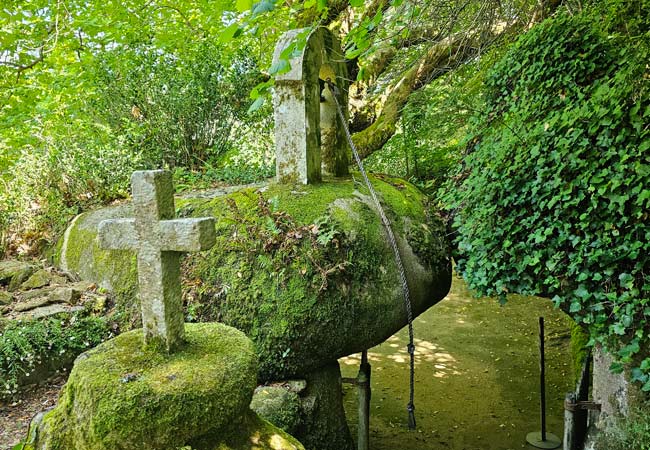
In stark contrast to Sintra's opulent palaces, this austere Franciscan convent is built into the granite boulders of the forest. Its humble, cork-lined cells exemplify a life of simple harmony with nature, offering the most atmospheric and contemplative experience in the region - Convento dos Capuchos guide
Palácio de Monserrate
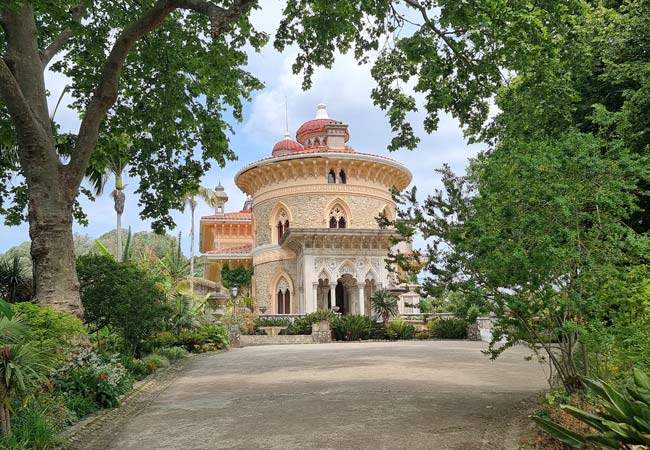
An exquisite jewel of Romantic design, this quiet palace features a delicate fusion of Gothic, Indian, and Moorish details in its intricate stonework. It is set within magnificent botanical gardens, offering a tranquil and less-crowded escape from Sintra's main monuments. - Palácio de Monserrate guide
Santuário da Peninha
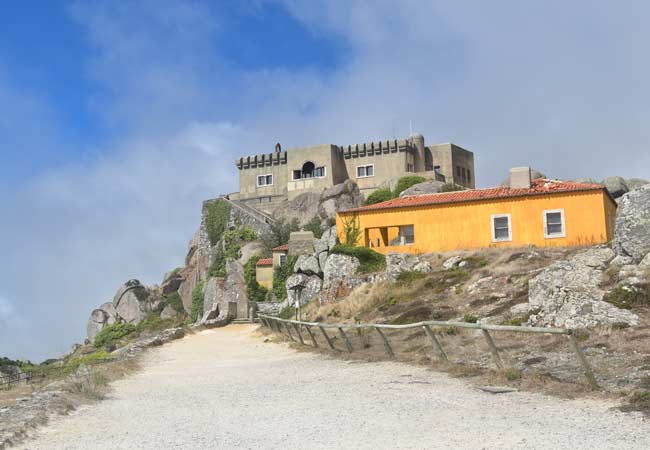
Perched atop a rugged, rocky outcrop, this small chapel offers what many consider the best viewpoint in the region. The windswept sanctuary provides stunning panoramic views over the entire wild coastline of the Serra de Sintra, far from the bustling tourist trails.
Praia da Ursa
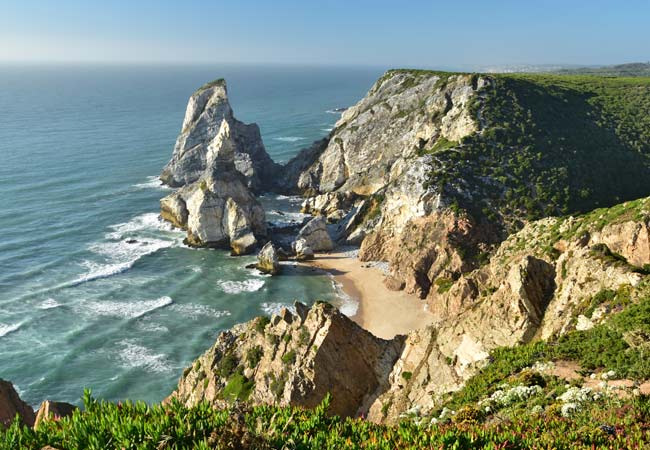
A stunning display of nature’s raw power, this remote beach is famed for its jagged sea stacks rising from the Atlantic. Accessible only by a steep cliffside footpath, its golden sands and untamed beauty offer a true sense of discovery on the Sintra coastline.
Azenhas do Mar

One of the region’s most picturesque sights, this charming village clings to a cliffside overlooking the Atlantic Ocean. Its white-washed houses and stunning natural sea pool, fed by the ocean tide, create a dramatic and unforgettable coastal scene.
The Sintra Tram
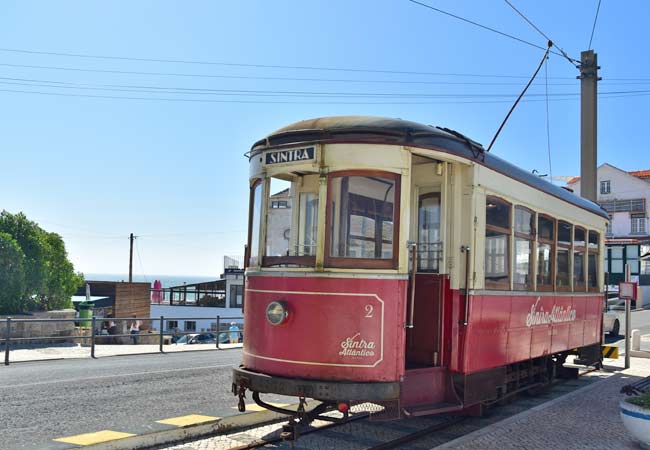
Take a delightful journey back in time on the historic tram connecting Sintra to the coastal town of Praia das Maçãs. The quaint, 100-year-old tram retains its original features, offering a bumpy, memorable, and scenic ride to the coast.
Quinta da Ribafria
A true hidden gem, this recently restored 16th-century estate offers a peaceful escape into Sintra's past. Centred around a medieval tower and surrounded by quiet Renaissance gardens, it provides a tranquil, non-touristy experience for those looking to avoid the crowds.
Other Lesser-Known Sights in Sintra
• Chalet da Condessa D'Edla - A whimsical Alpine-style cottage hidden in Pena Park, designed as a private, romantic nest for King Ferdinand II and his second wife.
• Sintra Bonsai Museum - A tranquil haven offering one of Europe's finest collections of miniature ancient trees, each a living work of art.
• Praia da Adraga - One of Sintra’s most striking beaches, famed for its dramatic cliffs and natural stone arch.
• Vila Sassetti - An enchanting path that winds through the lush gardens of a Mediterranean-style villa.
• Alto do Chá Viewpoint - The finest viewpoint within Pena Park, for picture-perfect photographs of the Palácio da Pena.
• Palácio de Seteais - An elegant Neoclassical palace, famed for its grand triumphal arch.
• NewsMuseum - An interactive museum dedicated to journalism and the media, that is ideal for families.
The interactive map below shows the location of these hidden gems and lesser-known sights of the Sintra region (Note: zoom out to see all of the points)
Legend: 1) Convento dos Capuchos 2) Palácio de Monserrate 3) Santuário da Peninha 4) Praia da Ursa 5) Azenhas do Mar 6) The Sintra Tram 7) Quinta da Ribafria 8) Chalet da Condessa D'Edla 9) Vila Sassett 10) Praia da Adraga 11) Alta da Cha 12) Bonsai Museum 13) NewsMuseum 14) Palácio de Seteais
Detailed guide to the hidden gems of Sintra
The Convento dos Capuchos
Hidden deep within the dense forests of the Serra de Sintra, the Convento dos Capuchos offers an experience that is a world away from the region’s opulent palaces. This humble 16th-century monastery was built to exemplify the Franciscan belief of living in complete harmony with nature, ensuring that humanity made minimal impact on the earth.
The entire complex is integrated into the landscape, with tiny, basic stone cells constructed around and within the area's massive granite boulders. The forest is not just a backdrop but a part of the structure itself, with ancient trees and moss-covered stones intertwined with the buildings.
The monks’ austere existence is evident throughout. To combat the damp chill of the hills, the only concession to comfort was lining the walls and ceilings with cork, a natural insulator harvested from the surrounding trees. This gives the convent its other name, the "Cork Convent".
The ultimate expression of this simplistic devotion is the main chapel, which is little more than a small cave. The convent provides a profoundly atmospheric and contemplative escape from the crowds, revealing a much simpler and more spiritual side to Sintra's history.
Related articles: Convento dos Capuchos

Dense forests cover the Convento dos Capuchos
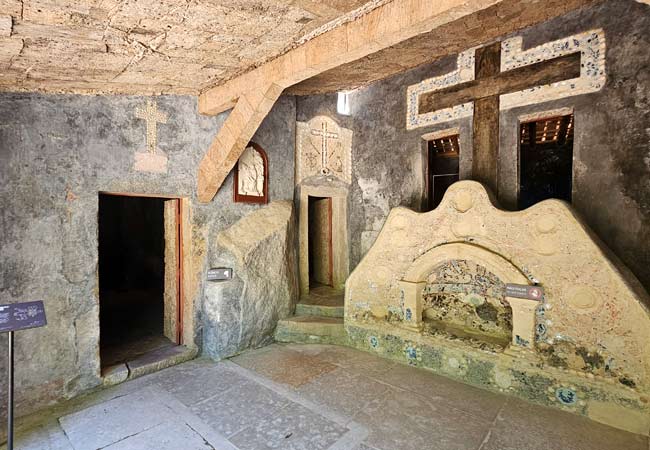
The simplistic altar is precariously balanced below a giant boulder
The Palácio de Monserrate
The Palácio de Monserrate is an exquisite jewel of Romantic design, offering one of Sintra's most tranquil and rewarding escapes. Far from the crowded main monuments, this quiet palace presents a fantasy of intricate, lace-like stonework. Its delicate architecture is a captivating fusion of Gothic, Indian, and Moorish styles, creating a building that feels both exotic and romantic.
The true wonder of Monserrate, however, extends beyond the palace walls and into its magnificent botanical gardens. Winding paths lead visitors through a world-class collection of exotic plants, thoughtfully arranged into beautiful and geographically distinct areas from across the globe
This harmonious blend of unique architecture and diverse nature provides a peaceful retreat from Sintra’s well-trodden paths, with a beauty that easily rivals the more famous Pena Palace
Related articles: The Palacio de Monserrate
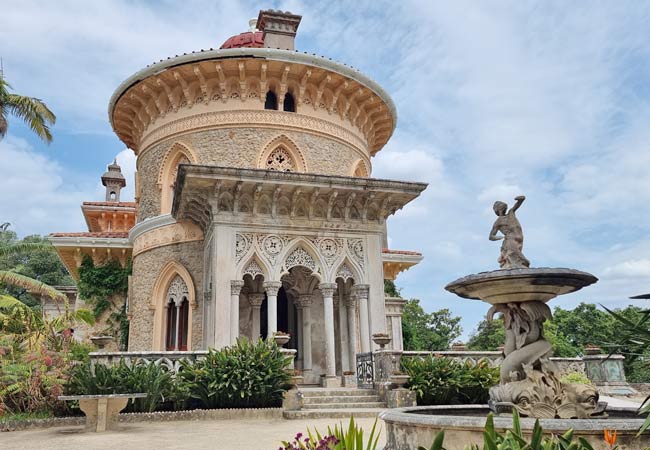
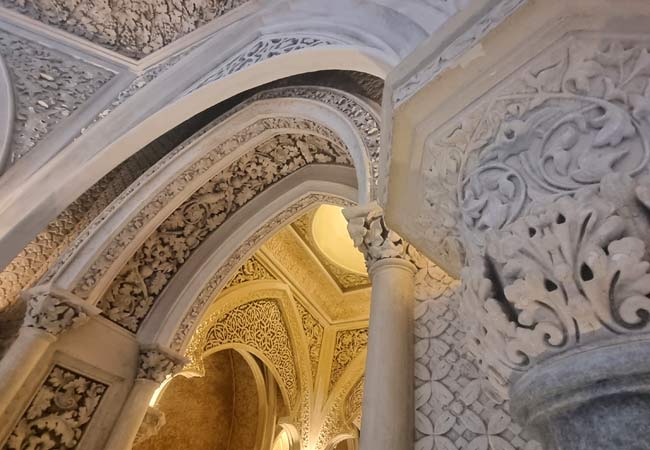
The beautiful stone carvings inside Monserrate
Capela de Nossa Senhora da Peninha
Perched high on a rugged outcrop, the Santuário da Peninha offers what many locals consider the best viewpoint in the entire Sintra region. From this windswept vantage point, stunning panoramic views unfold, stretching over the wild coastline and the vast Atlantic Ocean. The landscape here is raw and exposed, a dramatic contrast to the sheltered forests that surround Sintra’s palaces, offering a true sense of the region's untamed natural beauty.
The small, isolated chapel itself dates back to the 17th century, built on a site where an apparition of the Virgin Mary was said to have appeared. Next to it stand the atmospheric ruins of a Romanticist villa, constructed in the 19th century but quickly abandoned to the fierce coastal weather. This combination of spiritual history and dramatic scenery makes Peninha a rewarding detour from the main tourist trails.
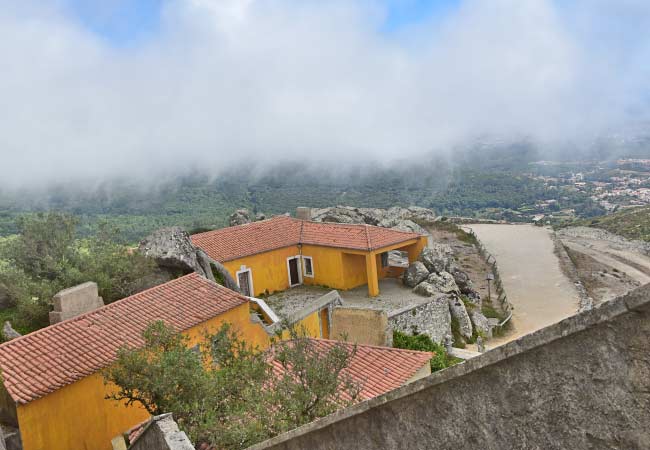
The Santuario da Peninha
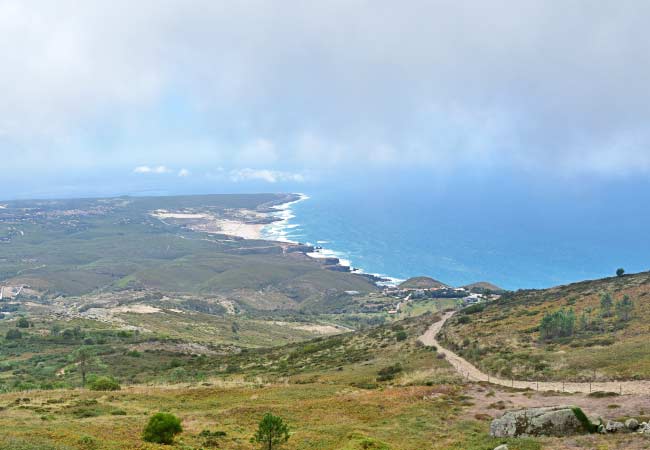
The view of Guincho beach and the Serra de Sintra coastline.
The Praia da Ursa beach
For those seeking the wild, untamed spirit of the Sintra coastline, Praia da Ursa is an unforgettable discovery. Famed for its dramatic sea stacks that rise from the powerful Atlantic surf, this secluded beach offers a stunning display of nature's raw power. The largest of these rock formations, the 'Rocha da Ursa' (Bear Rock), gives the beach its name and defines its rugged character.
Its golden sands remain pristine largely due to the challenging access. Reaching the shore requires a steep descent down an unmarked, winding footpath along the cliff face, a short but demanding trek that deters casual visitors. This journey, however, is precisely what preserves its untouched atmosphere. Those who make the effort are rewarded with one of Portugal's most beautiful and wild beaches.

The well-worn paths leading down to the Praia da Ursa
Azenhas do Mar
Azenhas do Mar is one of the most picturesque and photographed villages on the Sintra coastline. This charming settlement clings dramatically to the side of a cliff, its cluster of traditional white-washed houses standing high above the powerful Atlantic waves below.
At the base of the cliff lies the village’s most distinctive feature: a natural swimming pool carved into the rocks. This pool is filled by the ocean tide, offering a unique place to swim against a backdrop of the crashing surf and the small beach that appears at low tide. This blend of stunning scenery and local history creates a dramatic and unforgettable coastal scene.
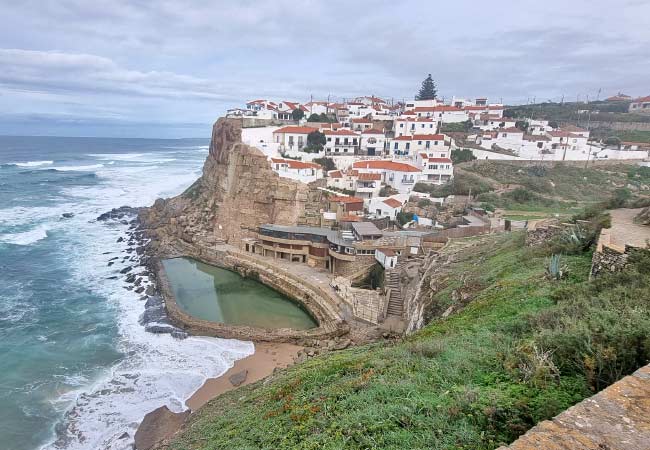
The Sintra Tram
Take a delightful journey back in time on the historic tram that connects Sintra with the charming coastal town of Praia das Maçãs. This quaint, 100-year-old tram trundles along a 12km route, offering a scenic and memorable ride through the countryside to the coast. The tram still retains many of its original features, from polished wooden benches to brass dials, providing an authentic early 20th-century travel experience.
The journey itself is an attraction. Expect a bumpy, noisy, and leisurely ride that takes around 45 minutes, as the tram rarely moves faster than a jogging pace. The destination, Praia das Maçãs (Apple Beach), is a popular and family-friendly beach town with a wide expanse of golden sand and a relaxed atmosphere. While the beach is lovely, the unforgettable part of the excursion is undoubtedly the charming tram ride to get there.


Cabo da Roca at sunset
As the westernmost point of mainland Europe, Cabo da Roca is a raw and windswept headland where granite cliffs plunge into the untamed Atlantic. It was here that the Romans believed the sun was extinguished each evening, and there is still a powerful, almost mystical quality to witnessing the day's end from this dramatic spot.
While the headland is a standard stop for coach tours during the day, its true magic is revealed at sunset. Watching the final golden rays of light illuminate the immense ocean before the sun dips below the horizon is an unforgettable experience. As the daytime crowds depart, a sense of solitude returns to the cliffs, allowing for a more personal connection with the magnificent scenery.
It is essential to come prepared, as the exposed headland is subjected to strong winds that can make it feel surprisingly chilly, especially as the sun goes down.
Related articles: Cabo da Roca guide
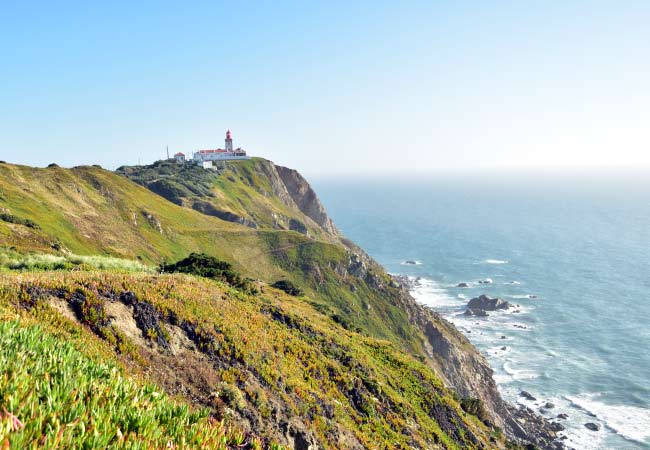
Quinta da Ribafria
For visitors seeking a genuine escape from the crowds, the Quinta da Ribafria is a true hidden gem. This recently restored 16th-century estate offers a peaceful journey into Sintra's past, far from the well-trodden tourist routes. The property is centred around an elegant manor house, complete with a distinctive medieval-style tower that gives it a unique, fairytale-like character.
Unlike the vast and exotic botanical gardens of Sintra's more famous palaces, Ribafria's charm lies in its quiet and formal Renaissance gardens. The villa and gardens provides an authentic, non-touristy experience for those looking to discover a more serene side of Sintra.
Chalet da Condessa D'Edla
Tucked away in a quieter, western section of the vast Pena Park is the Chalet of the Countess of Edla. It was conceived by King Ferdinand II and his second wife, Elise Hensler, as a private nest, a stark contrast to the royal grandeur of the main palace.
Designed in the style of a rustic Alpine cottage, the chalet has a wonderfully whimsical exterior. A key feature is the decorative use of cork around the windows and balconies, a direct inspiration from the humble Convento dos Capuchos. This personal project, designed by the Countess herself without a formal architect, reveals a unique character, full of romantic touches rather than perfect symmetry.
Surrounded by its own beautiful botanical garden rich with exotic species, a visit to the chalet provides a peaceful interlude. It reveals the more private and romantic side of Ferdinand and Elise's life in the serene Sintra hills.
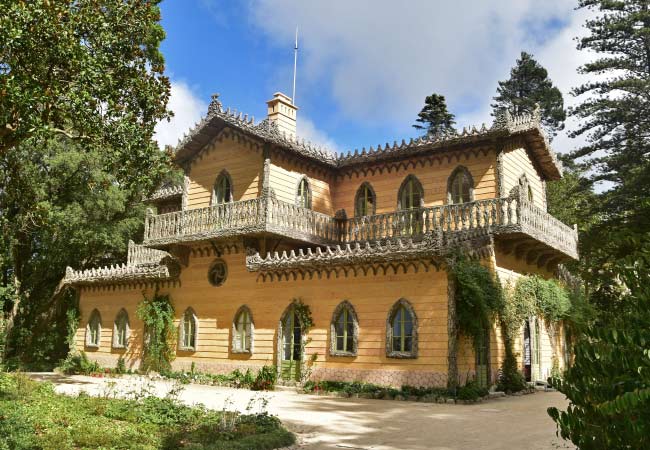
The pretty Chalet da Condessa D'Edla
Vila Sassett and Gardens
The grounds of Vila Sassetti offer a tranquil and enchanting walking route that meanders from the edge of Sintra's historic centre up towards the Castelo dos Mouros. This beautiful path provides a quiet alternative to the main roads, allowing you to begin the steep ascent to the hilltop monuments in a far more scenic and peaceful way.
As you follow the trail, it winds through lush, naturalistic gardens designed in the Romanticist style. Moss-covered stones, cooling streams, and shaded clearings create a wonderfully serene atmosphere. The path leads past the Vila Sassetti itself, an impressive Mediterranean-style villa inspired by the castles of Lombardy and designed by Luigi Manini, the same architect behind the Quinta da Regaleira.
While the villa is not open to the public, the real attraction is the journey through its magical gardens. Best of all, this delightful experience is completely free.
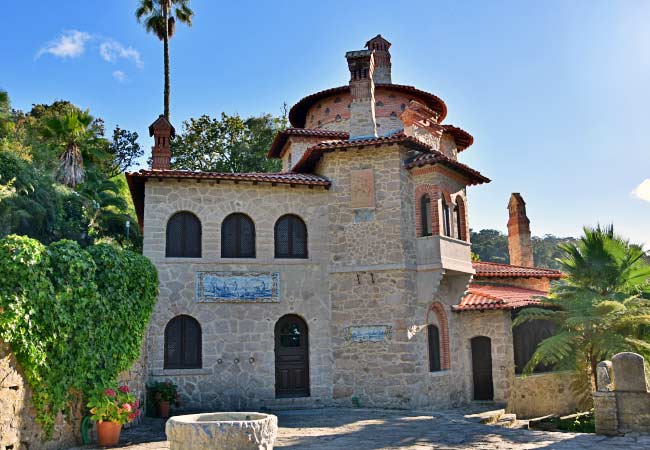
Praia da Adraga beach
Praia da Adraga is one of the most striking and accessible beaches on the raw and beautiful Sintra coastline. Sheltered by towering, dark schist cliffs, this cove is famed for its wide expanse of golden sand and dramatic rock formations that have been sculpted by the relentless power of the Atlantic.
At the southern end of the beach, a magnificent natural stone arch and a series of sea caves provide a fascinating landscape to explore, particularly during low tide.
Unlike its wilder neighbour, Praia da Ursa, Adraga’s untamed splendour can be reached directly by car, making it a popular choice for those seeking dramatic scenery without a challenging hike.
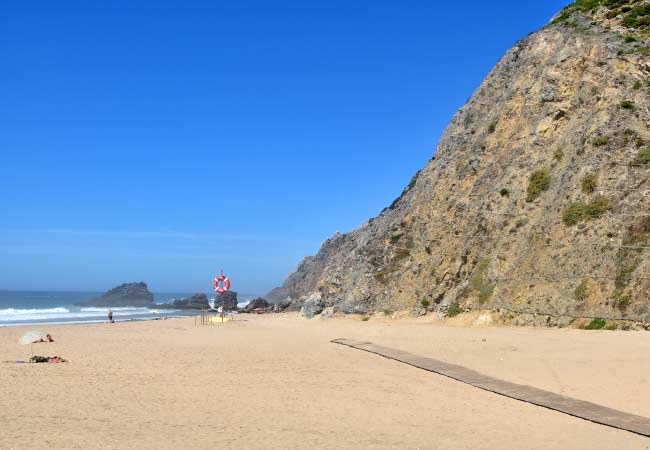
The Praia da Adraga
Palácio de Seteais
A world away from the Romanticist fantasies that define much of Sintra, the Palácio de Seteais offers a vision of refined Neoclassical elegance. The palace is defined by its magnificent triumphal arch, constructed to connect its two wings and commemorate a royal visit in the early 19th century.
This arch was intentionally designed to act as a perfect frame, offering a spectacular, direct line of sight to the distant Palácio da Pena. According to local legend, the palace’s name, meaning ‘seven sighs,’ was inspired by the breathtaking panorama visible from its grounds.
Today, the palace operates as a luxury hotel, meaning its lavish interiors are reserved for guests. However, visitors are free to wander through the formal gardens and approach the grand arch.
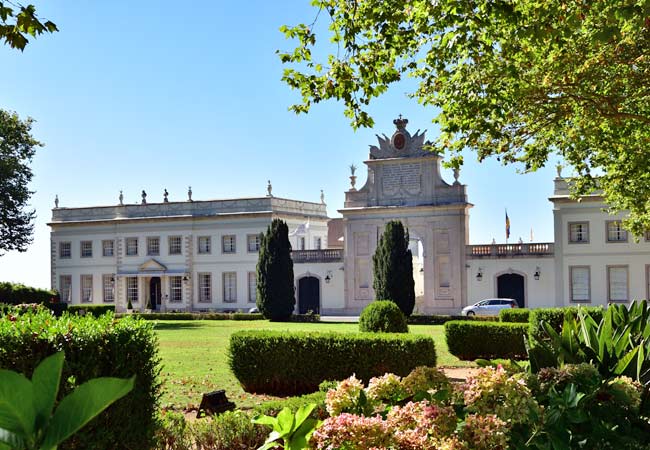
Alto do Chá Viewpoint
While the Cruz Alta offers the highest panoramic view over the Sintra region, the most iconic photograph of the Palácio da Pena is captured from the Alto do Chá viewpoint. Tucked away within the winding forested paths of the vast Parque da Pena, this spot was intentionally designed by King Ferdinand II to provide the definitive romantic perspective of his fantasy palace.
Interestingly, the viewpoint’s name is more literal than romantic. This was the site of the first experimental plantation of tea camellias (Camellia sinensis) in Portugal, planted in 1883 to test the viability of a national tea industry. This historic planting was also intended to create an ‘oriental scenery’ within the park.
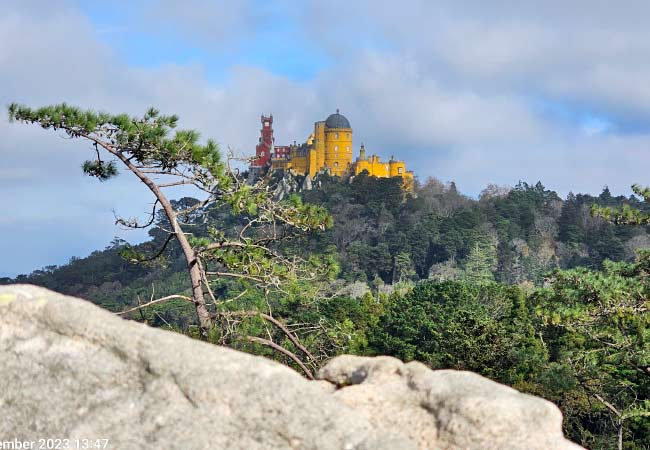
The view from the Alto da Chã
Sintra Bonsai Museum
An unexpected haven of tranquillity amid Sintra’s grand monuments, the Bonsai Museum offers a unique journey into the world of miniature ancient trees. This is not just a small exhibit but one of Europe’s finest collections, representing the personal passion of bonsai master Paolo Gandra. Visitors can wander through a serene outdoor space, admiring hundreds of meticulously sculpted trees, from ancient Portuguese olive and cork trees to classic Japanese maples and pines.
Each tree is a living work of art, some centuries old, providing a quiet and contemplative experience. For those with an interest in horticulture, or simply seeking a peaceful escape from the crowds, the museum provides a beautifully curated and unusual alternative to the region's palaces.
NewsMuseum
Located conveniently in the heart of the historic centre, this engaging museum is dedicated to the world of media, journalism, and communication. Rather than quiet halls of artefacts, visitors find a hands-on environment where they can step in front of a chroma key screen to present the news, record a radio broadcast, or report on major historical events.
The exhibits cover the evolution of media and also tackle important contemporary topics like propaganda and "fake news." For families, or anyone seeking a dynamic change of pace from the palaces and castles, the NewsMuseum provides a fun and thought-provoking diversion right in the centre of town.
Our most popular guides to Sintra
If you've found our content valuable, we'd welcome your support.
The digital publishing landscape has evolved significantly. As a small independent publisher, we face growing challenges. Search engines increasingly favour paid content over organic results, while AI-generated content often reproduces original work without attribution.
To support our work, please consider bookmarking this page (press Ctrl + D) for quick access. If you find an article helpful, we'd be grateful if you'd share it with friends on social media.
For specific questions, please see our Reddit community at r/LisbonPortugalTravel.
Should you notice any outdated or incorrect information, please contact us at [email protected]
Thank you for helping us continue to provide valuable content in an increasingly challenging digital environment.
A complete list of all of our Sintra and Lisbon guides
If you've found our content valuable, we'd welcome your support.
The digital publishing landscape has evolved significantly. As a small independent publisher, we face growing challenges. Search engines increasingly favour paid content over organic results, while AI-generated content often reproduces original work without attribution.
To support our work, please consider bookmarking this page (press Ctrl + D) for quick access. If you find an article helpful, we'd be grateful if you'd share it with friends on social media.
For specific questions, please see our Reddit community at r/LisbonPortugalTravel.
Should you notice any outdated or incorrect information, please contact us at [email protected]
Thank you for helping us continue to provide valuable content in an increasingly challenging digital environment.





























